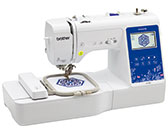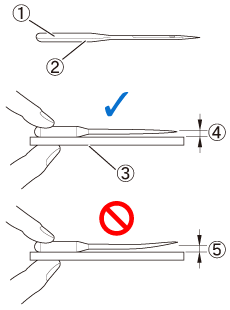Innov-is NV180
FAQs & Troubleshooting |

Innov-is NV180
Date: 21/07/2017 ID: faqh00000004_006
Combination of fabric, thread and needle
Fabric / Thread / Needle Combinations
The machine needle and thread that should be used depends on the type and thickness of the fabric. Refer to the following table when choosing the thread and needle appropriate for the fabric that you wish to sew.
- The combinations shown in the table provide a general guideline. Be sure to sew trial stitches on the actual number of layers and type of fabric to be used in your project.
- The machine needles are consumables. For safety and best results, we recommend replacing the needle regularly. For details on when to replace the needle, refer to Checking the needle.
- In principle, use a fine needle and thread with lightweight fabrics, and a larger needle and heavier thread with heavyweight fabrics.
-
Select a stitch appropriate for the fabric, and then adjust the stitch length.
When sewing lightweight fabrics, make the stitch length finer (shorter). When sewing heavyweight fabrics, make the stitch length coarser (longer).
When sewing stretch fabrics, use a pattern suitable for sewing stretch fabrics.
|
Fabric Type/Application |
Thread |
Size of needle |
Stitch length mm (inch) |
||
|---|---|---|---|---|---|
|
Type |
Weight |
||||
|
Lightweight fabrics |
Lawn, georgette, challis, organdy, crepe, chiffon, voile, gauze, tulle, lining, etc. |
Polyester thread |
60 - 90 |
65/9 - 75/11 |
Fine stitches
1.8 - 2.5 |
|
Cotton thread, Silk thread |
50 - 80 |
||||
|
Medium weight fabrics |
Broadcloth, taffeta, gabardine, flannel, seersucker, double gauze, linen, terry cloth, waffle weave, sheeting, poplin, cotton twill, satin, quilting cotton, etc. |
Polyester thread |
60 - 90 |
75/11 - 90/14 |
Regular stitches
2.0 - 3.0 |
|
Cotton thread, Silk thread |
50 - 60 |
||||
|
Heavyweight fabrics |
Denim (12 ounces or more), canvas, etc. |
Polyester thread, Silk thread |
30 |
100/16 |
Coarse stitches
2.5 - 4.0 |
|
Denim (12 ounces or more), canvas, tweed, corduroy, velour, melton wool, vinyl-coated fabric, etc. |
Polyester thread |
60 |
90/14 - 100/16 |
||
|
Cotton thread, Silk thread |
30 - 50 |
||||
|
Stretch fabrics (knit fabrics, etc.)
|
Jersey, tricot, T-shirt fabric, fleece, interlock, etc. |
Polyester thread, Cotton thread, Silk thread |
50 |
Ball point needle 75/11 - 90/14 |
Setting appropriate for the fabric thickness
|
|
For top-stitching |
Polyester thread |
30 |
90/14 - 100/16 |
Setting appropriate for the fabric thickness |
|
|
50 - 60 |
75/11 - 90/14 |
||||
-
Needles that can be used with this machine: Home sewing machine needles (size 65/9 - 100/16)
- The larger the number, the larger the needle. As the numbers decrease, the needles get finer.
-
Thread that can be used with this machine: 30 - 90 weight
- Never use thread of 20 weight or lower. It may cause machine to malfunction.
- The smaller the number, the heavier the thread. As the numbers increase, the thread gets finer.
-
Transparent nylon thread:
Use a home sewing machine topstitching needle, regardless of the fabric or thread.
The appropriate fabric, thread and needle combinations are shown in the preceding table. If the combination of the fabric, thread and needle is not correct, particularly when sewing heavy fabrics (such as denim) with thin needles (such as 65/9 to 75/11), the needle may bend or break. In addition, the stitching may be uneven or puckered or there may be skipped stitches.
Checking the needle
- Only use sewing machine needles for home use. Other needles may bend or break and cause injury.
- Never sew with a bent needle. A bent needle will easily break and cause injury.
Sewing with a bent needle is extremely dangerous since the needle may break while the machine is being operated.
Before using the needle, place the flat side of the needle on a flat surface and check that the distance between the needle and the flat surface is even.
 |
(1) Flat side |
|
If the distance between the needle and the flat surface is not even, the needle is bent. Do not use a bent needle. |
|
The needles are consumables. For safety and best results, we recommend replacing the needle regularly.
Replace the needle in cases such as the four described below:
- If an unusual sound is produced when the needle enters the fabric while sewing trial stitches. (The tip of the needle may be broken or dull.)
- If stitches are skipped. (The needle may be bent.)
- Generally, after completing one project, such as a piece of clothing.
FS60X, FS80X, Innov-is A150, Innov-is A16, Innov-is A80, Innov-is M370, Innov-is NV180, Innov-is XJ1, Innov-is XP1, Innov-is XP2, Innov-is XP3
If you need further assistance, please contact Brother customer service:
Content Feedback
Please note this form is used for feedback only.